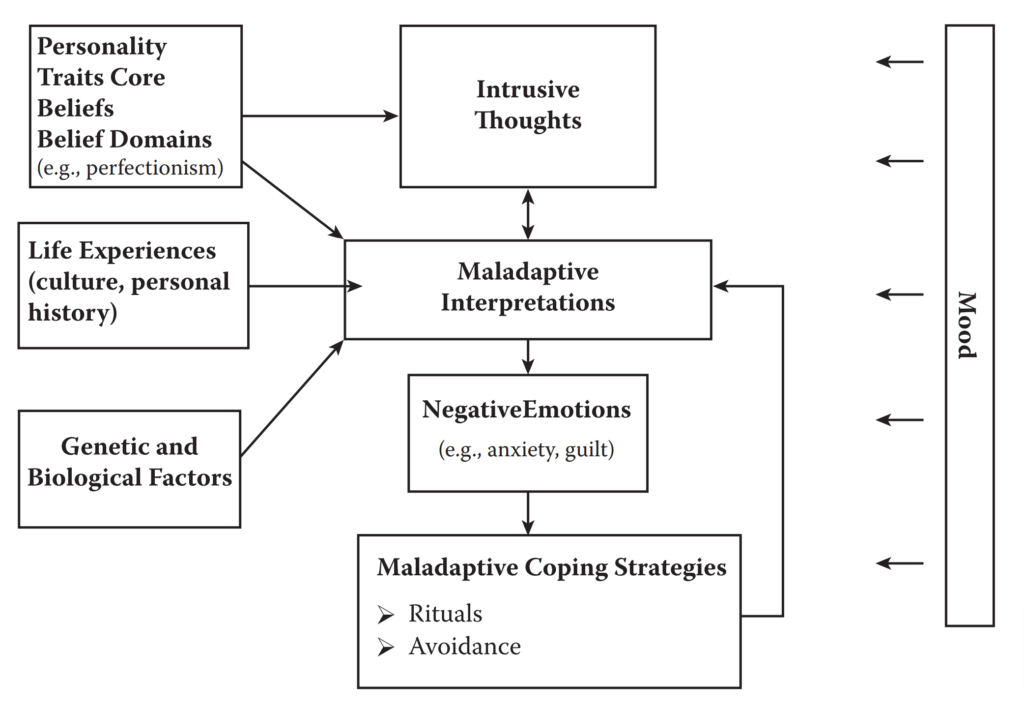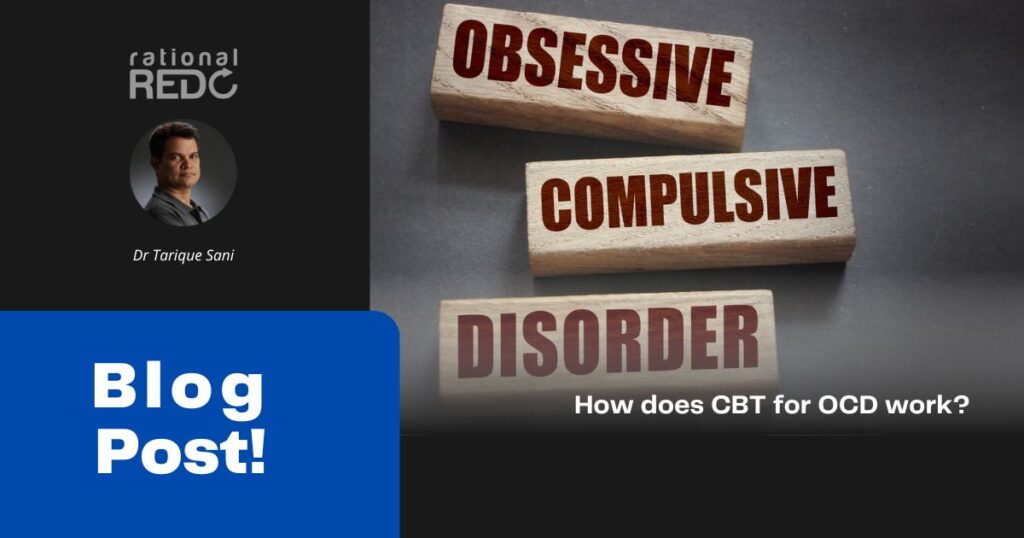CBT for OCD was recently helpful for Sushma, who would often get late for meetings because she spent too much time repeatedly checking if all the electrical appliances were turned off, the gas was turned off, and then repeatedly locking and unlocking doors to ensure they were indeed secure. This article describes what OCD is and how CBT for OCD works.
Understanding what OCD is.
While the word OCD, Obsessive, Compulsion is often used by many in everyday language, the term “obsessive-compulsive disorder” or OCD describes a group of mental health conditions that cause problems with thoughts and behaviors.
OCD is characterized by a pattern of unpleasant thoughts and fears (obsessions) that cause you to engage in repetitive actions (compulsions). These obsessive thoughts and compulsive behaviors disrupt daily life and create significant discomfort.
You may try to suppress or dismiss your obsessions, but doing so makes you feel more upset and anxious. In the end, you are compelled to engage in compulsive behaviors to reduce stress. Despite attempts to suppress or dismiss unwanted thoughts or desires, they persist. This feeds the OCD cycle, which results in more ritualistic behavior.

It can be said that OCD is driven by anxiety and reinforced by a faulty way of dealing with those anxieties, that is, by indulging in ritualistic or compulsive behavior with the hope that by doing it, the anxiety will decrease.
Obsessions and compulsions, both are frequently present in patients with obsessive-compulsive disorder. However, it’s also possible to only have obsessive or only have compulsive symptoms. In addition, the obsessions and compulsions may or may not appear severe or irrational. Still, they consume a lot of time and prevent the patient from going about everyday activities and functioning in social, academic, or professional areas.
What are the common obsessive symptoms?
Obsessions in OCD are intrusive, recurrent, unwelcome thoughts, desires, or images that produce distress or anxiety. Sufferers try to avoid or eliminate them by engaging in a ritual or compulsive habit.
Obsessions frequently have underlying themes, such as:
- Aversion to dirt or contamination – Fear of getting sick after handling things that other people have touched
- Having doubts and finding it difficult to accept uncertainty – Doubts about whether you properly closed the door or switched off the stove
- Requiring symmetry and order in everything – When things aren’t in a particular order or facing the right way, it causes anxiety.
- Ideas that are violent or horrifying, often about losing control and hurting oneself or others – Thoughts of ramming your car into a crowd. Thoughts of yelling obscenities, insults, or misbehaving in public
- Unwanted ideas, such as those that are hostile or deal with sexual or religious issues – Unwanted sexual images, often involving forbidden relations.
What are the common compulsive symptoms?
Compulsions in OCD are repetitive behaviors that one feels compelled to carry out. These recurrent actions, whether physical or mental, are intended to ease anxiety brought on by the obsessions or avert adverse outcomes. However, indulging in the compulsions is mostly futile and can only provide a short-term reduction in anxiety.
When experiencing obsessive thoughts, sufferers create rules or rituals that they think they must adhere to manage their anxiety. Unfortunately, these obsessions are excessive and frequently have no connection to the issue they are meant to solve.
Similar to obsessions, compulsions too have themes, such as:
- Cleaning and washing – Washing hands excessively
- Checking – Repeatedly ching the stove or door lock.
- Counting – Counting in patterns. Repeating prayers X times
- Orderliness – Arranging things in a particular manner.
- Maintaining a rigorous schedule.
- Repeatedly seeking reassurance
Obsessive-compulsive disorder is often accompanied by depression and/or anxiety; symptoms can sometimes worsen or improve depending on the individual.
What does CBT for OCD entail?
OCD was thought to be treatment-resistant until the middle of the 1960s when psychodynamic psychotherapy and medication could not appreciably lessen OCD symptoms. Then, exposure and ritual/response prevention were introduced in 1966, marking the first significant treatment advancement.
As many of you know, cognitive behavioral therapy (CBT) is evidence-based talk therapy. CBT is based on the idea that your thoughts, feelings, and actions can influence each other. Thus by changing your thoughts or changing the action you take, you change your suffering.
What is the exposure and ritual prevention technique in CBT for OCD?
Two sorts of associations that arise in OCD are intended to be broken by the exposure and ritual prevention technique.
The first is the association between objects, situations, or ideas and distressing feelings.
The second association is that ritualistic conduct reduces discomfort when it is practiced.
Exposure and ritual prevention severs the ingrained link between anxious feelings and ritualistic actions. Additionally, it teaches you how to avoid ritualizing when you feel anxious.
The technique has four components in-vivo exposure, imaginal exposure, ritual prevention, and processing.
During exposure, you purposefully come into contact with things or situations that make you uncomfortable and remain there long enough for your anxiety to subside naturally. A kind of exposure known as “in vivo exposure” is coming face to face with dreaded things and circumstances in “real life.”
For instance, someone who fears being contaminated in public restrooms can go there and stay there long enough for their anxiety to subside. OCD sufferers have a mistaken belief that their discomfort will last forever or they will not be able to tolerate the situation at all. At first, they experience anxiety and distress, but with exposure practice, these situations are no longer as distressing as before. This is called habituation.
Imaginal exposure is used when real-life exposure is not possible or as a prelude to real-life exposure. It is also used where there is no identifiable external situation, like having inappropriate sexual thoughts.
In imaginal exposure, you visualize the catastrophe that, in your view, will happen if you don’t prevent it or practice a ritual. Like actual exposure, imaginal exposure causes obsessional anxiety progressively lessens with practice.
When faced with their feared situations or obsessive thoughts, people with OCD become anxious and feel compelled to engage in rituals to reduce this anxiety. Exposure brings them face-to-face with the same anxiety and urges.
Ritual prevention entails encouraging the patient to stop engaging in the behavior they believe would avert the feared catastrophe or lessen the anxiety it causes (e.g., washing hands after touching the floor and fearing contracting a disease). The person learns that anxiety and discomfort lessen without ritualizing and that the feared consequences do not occur.
Processing entails talking about the patient’s experience during or after exposure and response prevention and how this experience confirms or contradicts the patient’s expectations.
For example, you touched the floor and did not wash your hands for about an hour; is your level of distress as high as it was at the start of the exposure? How compelled are you to wash? Are they as powerful as you thought? If not, what did you take away from the situation?
Processing helps the person with cognitive restructuring by using the facts learned from exposure and ritual prevention.
Conclusion
Exposure and ritual prevention might be challenging at times. To face the circumstances you would typically avoid takes effort. However, as you practice exposure, you will learn that anxiety and suffering subside without rituals. These exercises get easier and easier as you practice exposure, and your impulses to ritualize will lessen. Want to talk about it? Have virtual coffee with me.

I help IT executives overcome anxiety, overwhelm and procrastination, unleashing their potential using 1:1 CBT sessions | Assertiveness Training | Burn-out Prevention | Beat Perfectionism | Crush Imposter Syndrome
